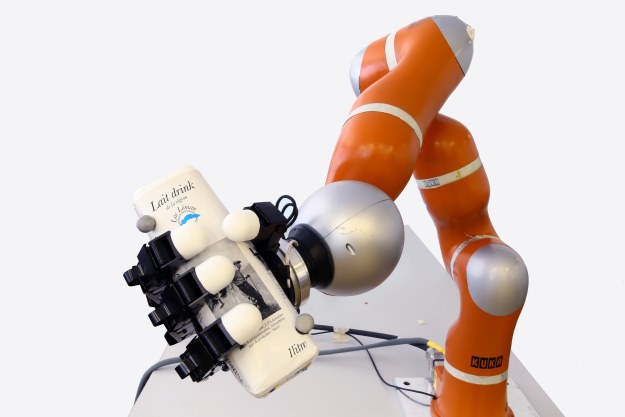Not only are robots looking more like humans and getting smarter just like humans, now they’re getting some cat-like reflexes.
A robot developed by École polytechnique fédérale de Lausanne (EPFL) researchers can react on the spot and grab object in less than five-hundredths of a second.

The bionic arm. (Image via EPFL)
In the video, you’ll see the robotic arm with its palm open, completely motionless. Then, in a split second, it unwinds and catches flying objects — a tennis racket, a ball, and a bottle.
The arm is about 5 feet long with three joints and a four-fingered hand. The Learning Algorithms and Systems Laboratory at EPFL programmed and designed the arm to test for robotic solutions for capturing moving objects.
Watch this arm in action now.
“Increasingly present in our daily lives and used to perform various tasks, robots will be able to either catch or dodge complex objects in full motion. Not only do we need machines able to react on the spot, but also to predict the moving object's dynamics and generate a movement in the opposite direction,” said Aude Billard, head of the Learning Algorithms and Systems Laboratory.
Future applications
It’s not only cool to look at, but the robotic arm could have some realistic potential applications in space disposing of recovering and disposing of debris orbiting around Earth. The arm would be situated onto a satellite and catch the flying debris and would not be able to predict the characteristics of the flying objects until it’s there, which is why it’s so important that it be fast-acting.
In order to give the arm this sort of capability, the researchers were inspired by the human learning tactics of imitation and trial and error. The technique they used is called Programming by Demonstrations and does not give the robot specific instructions. Instead, the researchers show it examples of possible trajectories and manually guide the arm to the target repeatedly.
They tested the arm on five common objects: a ball, an empty bottle, a half full bottle, a hammer and a tennis racket because once they’re in the air, they will make even more complex and unpredictable movements.

Bionic hand ready to catch an object. (Image via EPFL)
In the first learning phase, objects are thrown several times in the robot's direction. Through a series of cameras located all around it, the robot creates a model for the objects' kinetics based on their paths, speeds and rotational movement.
During the few milliseconds of the object’s approach, it refines and corrects the path for a real-time and high-precision capture. This efficiency is further enhanced by the development of controllers that couple and synchronize the movements of the hand and fingers.
If he fails in space, he can always play some major league baseball though.
Advertisement
Learn more about Electronic Products Magazine





